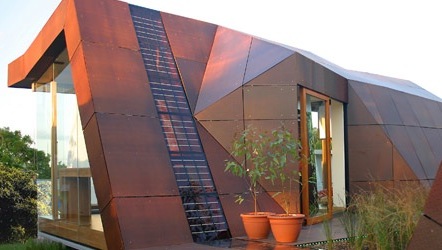
National Design Triennial: Why Design Now?
Cooper-Hewitt, National Design Museum
2 East 91st Street
Through January 9, 2011
Where do you find Norman Foster’s vast Masdar sustainable city in Abu Dhabi in the same galleries with self-adjustable $19 eyeglasses and a millet thresher powered by bicycle pedals?
High and Low Solar: Rechargeable battery Lanterns (top) by Sunlabob Renewable Energy and the Hope Solar Tower by EnviroMission.
|
At the Design Triennial at the Cooper-Hewitt, National Design Museum, the criteria this year seem to be urgency of need, a project’s minimal impact on the planet, and an indifference to most aesthetic considerations. The show makes you feel that a clock is ticking, and much of what you see is design on deadline.
Who cares about sculptural harmony if you have a planet to save? Today’s ungainly hybrid vehicles and solar tiles are expected to be superseded. The problem is that they’ll be superseded in a lot less than three years. If the challenges facing design are as serious as the decoratively-deprived show’s curators insist that they are, this should be an annual event.
In the three-year straitjacket, the status quo of the French AGV train ends up alongside the cutting edge of a Dutch Soil Lamp, powered by dirt, along with a nod to fashion in $4,000 Issey Miyake dresses that replicate jungle colors. Calling the exhibition a mixed bag is like calling the iPhone a successful product. Yet the scattershot Design Triennial compares favorably to the grab bag of novelty at the Whitney Biennial. The Cooper-Hewitt foregrounds function over form, but its values are in the right place.
Its galleries still aren’t. In a design universe that metamorphoses by the minute, the Cooper-Hewitt remains as awkward as ever, with cramped spaces where large-scale objects can’t fit. If any place needed a revolution in exhibition design, this is it. Don’t hold your breath.
It’s the curators’ good luck that one strong area of design innovation tends to be museum-unfriendly: communications and information graphics. You can look at these works on the Internet, where its audience is. Social marketing sites like Etsy prove to be as welcome to anything handmade as glam sites are to gossip or dating. Annie Leonard’s The Story of Stuff, a first-person animated video available online, is a witty environmental primer in all of 20 minutes, targeted for youth who don’t know who Al Gore is.
Architecture here isn’t so much about the design of space or form but the positive use of it. At Snøhetta’s much-published Norwegian National Opera and Ballet in Oslo, the structure becomes more sloping waterside plaza than palace, for visitors who’ll never venture inside to see an opera. The New Carver Apartments, a sprocketed tower designed by Michael Maltzan, looks prison-like next to the Santa Monica Freeway, but it’s housing the homeless. The modular Loblolly House by KieranTimberlake can be assembled and taken apart with one wrench.
Ease of use is once again a theme with the iPhone and Kindle on view—two devices that champion simple operation, extreme portability, and tempting forms. Why not try that with condoms, given South Africa’s 10 percent HIV rate? The 4:Secs Condom Applicator Generation II is just that: a rapid deployment device that takes no time to weaponize. Elsewhere in the field of health, and in a rare nod to the military as innovator, the brave new field called biomimicry makes its appearance in an armadillo-styled suit that protects workers disarming landmines.
In an exhibition minimizing style, there’s a proto-military look to another valuable product: the Solvatten Solar Safe-Water Provider, a hinged carrying case that holds ten liters of water that can be purified by UV and heat from solar energy. Potability and portability literally go hand in hand, eliminating the long daily trek that millions make each day for drinkable water.
You can exit with a smile on an otherwise Boy Scout march through the healing of the planet: The Return to Sender Artisan Eco-Casket, designed by Greg Holdsworth of New Zealand, is my choice for Best in Show. The torpedo of a buffed plywood container lacks the lavish funereal accoutrements that bury 30 million board feet of hardwood, 3,000 tons of copper and bronze, and 90 thousand tons of steel in the U.S. every year.
And this elegantly minimal vessel is not comfort-free. A wool mattress sits on a flat surface with carved handles. The goal, once again, is the small footprint, even for that journey into eternity. Yet in three years—a design eternity—we may have an efficient stove for pollution-free home DIY cremation. Think of the square miles of cemetery land that would be spared.
Read all of AN‘s Friday Reviews here.